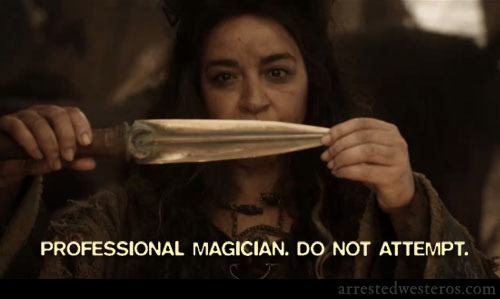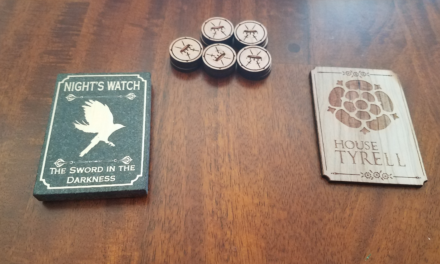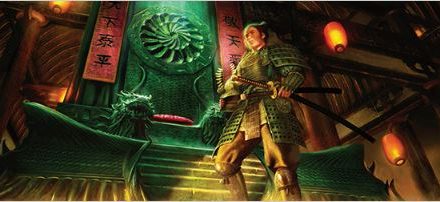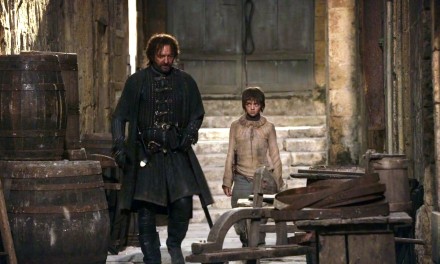Before you react to the article title, let me preface this by saying that I don’t think any one card is overpowered or imbalanced from a cost to impact standpoint and needs to be fixed, but I am beginning to become concerned with the amount of kill being added to the game, on the whole.
A Visit to the Past
In order to fully understand why I am concerned about this much kill, we have to go back to AGoT 1.0 (I know, I know, but it’s important). I did not personally play 1.0, but there seemed to be a complete devaluation of high cost characters for a number of reasons. The primary reason, as I understand it, was how easy it was to clear big characters off the board. Not only were there more kill effects (including a fairly common keyword called deadly, which, in a challenge, if the attacking player controls the most participating characters with the deadly keyword, the defending player must choose and kill a defending participating character after the challenge resolves), but also dupes were a card effect (read: a cancelable action) rather than a player action. This meant that it was rarely a safe feeling to use a dupe as claim soak and, in the event that your opponent had a kill card, they could cancel your duplicate’s effect to kill a character even with a dupe or two on them. Then there was Brienne of Tarth, who was 1.0’s version of Catelyn Stark, who made your opponent unable to trigger effects (like saving a character with a duplicate.) This dupe issue has been resolved in 2.0, as dupes are no longer cancelable and are a player action. The next reason is that control was better. I’ve been very vocal about my dislike of Baratheon and their soft control since the game began but every 1.0 player I talk to tells me that 2.0 Bara doesn’t have shit on the control available in 1.0, primarily out of Lannister. This made having big characters not great either because they were apparently so easy to control. The third reason that I’ve been able to get out of 1.0 players is Valar Morghulis (and other similar resets), which was a plot that killed all characters in play. This made running 2x or 3x of any character not that desirable as, at any time, your opponent could kill all your characters in play and, if you were running dupes of them, they’d be dead draws later in the game.
For these reasons, many 1.0 decks included 1x of many unique characters and emphasized efficiency over splashy effects. It was not uncommon to have several nameless or unknown characters in a deck because they were nonunique and therefore could not be dead draws post Valar/kill event. One such example was Distinguished Boatswain, which was a 4 strength, military and power character for 1 gold. He gained -2 strength for each card in shadows, but the efficiency there is just insane. There are many more examples (for more examples, speak to your local 1.0 players).
FFG’s New Design Strategy
When FFG released AGoT 2.0, they made it clear that they wanted to re-adjust the game so that the big characters were more valuable. It is Game of Thrones after all. A Stark deck should be running Eddard Stark and a Lannister deck should be running Tywin and Tyrion Lannister etc.
And so far, they’ve backed up that strategy by limiting the number of resets available, limiting the number of kill effects, not including Valar Morghulis in the core set or first cycle (although it is supposedly going to show up at some point) and releasing First Snow of Winter to emphasize 4+ cost characters. In addition, more saves have been printed in this cycle, including Iron Mines, Blood Magic Ritual, Risen from the Sea, and immunity effects such as Drowned God’s Blessing and the Eyrie. The only pure reset in the game (Varys) did not kill characters, but discarded them, meaning dupes were still, or even more, valuable. These were all positive moves made by the design team that fell in line with their design goals of emphasizing big characters. But, as the first cycle has wrapped up in the past 2 months, they released a rather large dose of targeted kill that is making me wonder if they are losing focus on their intended design strategy that they highlighted at the beginning of the new edition.
Now, that’s not to say that I think kill doesn’t belong in the game. I think Put to the Sword and Tears of Lys are very important cards that help balance a game that can be so easily swung with one big character being released. And, when Valar Morghulis does eventually come out, it will be an important plot to regain or press your advantage in a lot of interesting ways. There needs to be a balance between wanting to play big characters, but also ways to deal with the big characters that your opponent plays. However, most of the kill effects up to this point have been events (1.) with a gold cost that needs to be saved until they are used (2.) that have the potential to be cancelled (3.).
These are three extremely important counterbalances for the cards’ rather large impact on the game. Let’s dive into this a little bit.
- As I said, prior to this first cycle, most targeted kill was limited to events and attachments that discarded after use, such as Ice and Throwing Axe. This means that you only got one use out of that card. You had to save your Dracarys!, Put to the Sword or Tears of Lys for the target you most wanted to kill. The only kill that was repeatable were effects like Greywind or Plaza or Punishment, which had limited target pools.
- There are no free kills in the game. If you had no gold, or one of the attachments on the board, your opponent knew you didn’t have any targeted kill available to you, other than the minor kills like Greywind or Plaza. For this reason, if your opponent did save 2 gold, you could attempt to prevent them from winning Military by 5 or more, therefore wasting that 2 gold if they did indeed have a Put to the Sword in their hand. A few turns of not triggering your Put to the Sword after saving 2 gold for it adds up real quick in terms of economic disadvantage (Well, unless you have Tyrion…But that’s a completely different topic of discussion…)
- Each event had a neutral card, Hand’s Judgment, that cancelled it. So you couldn’t rely solely on that one Put to the Sword to swing your turn, because your opponent may have a Hand’s Judgment to cancel it. This made kill cards risky because you could use the card, spend the gold and then not get the effect from it, which is means you wasted cards, wasted gold and your entire strategy was altered. Now, this doesn’t apply to Ice and Throwing Axe, but there’s a reason Ice is considered one of the absolute best cards in the entire game.
In the first 4 chapter packs, there were a few direct kill effects released: Seastone Chair, Crown of Gold and the Watcher on the Walls. Each had its own counterbalances built in. Seastone Chair had to be an unopposed military challenge and could only target characters without attachments. Crown of Gold was not only limit 1 per deck, but also cost 4 gold (by far the most expensive one time use kill effect) and could only immediately kill a character with 4 strength or less (and it could be confiscated or otherwise destroyed if your character survived the turn.) Watcher on the Walls could only be used on a military challenge and required 2 rangers be available to kneel in order to use it. They all have had an impact on the meta, but each came with their own counterbalances that made them somewhat unreliable and not so dominating in the meta.
Now, with ALL that set up, let’s get to the actual discussion of the article.
Where the Counterbalances at?
In the past 2 chapter packs, FFG has released Mirri Maz Duur, Tyene Sand and Ser Ilyn Payne. These are three characters that have a printed ability that allows them to kill a character under certain circumstances. Mirri can kill any character if she can win a challenge by herself, whether that challenge be military, intrigue or power. Tyene Sand can kill any character without an intrigue icon after winning an intrigue challenge (does not have to be alone). And Ser Ilyn Payne can, as a marshalling action, kill any character with printed cost 3 or less.
Not only do these kills not meet any of the three counterbalances that existed in the core set (one time use, gold cost and easy to cancel), but they also are way more impactful than the existing kill effects that did not meet the aforementioned counterbalances. Ser Ilyn is not as impactful as Mirri and Tyene, as he does have a significant targeting restraint, but his ability to remove claim soak as well as fairly impactful 3 costers (Like Margaery, any maester, Arya, Sansa, any dragon, Jorah, the Hound, etc) makes your military challenges more impactful, so it’s kind of a wash.
Joe’s Bold Prediction
In my completely unprofessional and untested opinion, having Tyene Sand (along with Mirri Maz Duur, Ser Ilyn Payne and Ser Gregor Clegane) exist in this game, once again, begins the trend of devaluing high cost characters in the game.
….But Y Tho?
Intrigue is an interesting challenge type because it seems to be the only one where, across the board, your impactful characters kind of need the icon to remain truly safe. If your main character lacks a power icon, they are no more susceptible to being killed than if they had the power icon. If your main character lacks a military icon, they couldn’t participate in defending against a big military challenge with, potentially, a Put to the Sword on the line, but they couldn’t specifically die because of their lack of the military icon. But lacking an intrigue icon has always been a relatively dangerous position to be in because, for 1 gold and 1 single lost intrigue challenge (of any strength value), you could kiss your most important character goodbye. But even then, you could load your deck with Hand’s Judgments to cancel the Tears of Lys, or give your important characters a bodyguard or a duplicate to dissuade your opponent from using a Tears of Lys on them. They only have 3 possible uses anyway, so they wouldn’t waste one just to remove a dupe in most cases.
In addition to this unique distinction with the intrigue icon, it is also the one challenge that seems to have, across the board, factions that are either extremely powerful and extremely weak in the challenge. All factions are relatively secure in the military and power challenge department. You could make an argument that Lannister is weak in power, but that’s only when you’re taking into account that you can remove power icons from their best characters, which encompasses all of…1 faction. But intrigue is almost completely dominated by Martell, Lannister and Targaryen (if built for Mirri or Dany). Stark, Greyjoy, Baratheon, The Night’s Watch, Tyrell (at least those that are built with Randyll and KoF) and Drogo based Targaryen decks are very susceptible to Tears of Lys and, now, Tyene Sand simply based on the character pool available to them. Greyjoy, especially, has a total of 5 intrigue characters, with only 2 of them having more than 2 strength. Good luck stopping a Tyene Sand intrigue challenge every single turn with that deck. And that’s not even taking into account the fact that Tyene happens to be part of the one faction that can remove intrigue icons from characters, not only increasing her target pool but also making winning the intrigue challenge almost trivial.
With even a modest board state of Tyene and a few intrigue icon characters, you could be looking at what amounts to a Tears of Lys ever single turn. God forbid they combo Tyene with the actual Tears of Lys to create two kills per intrigue challenge. This means using Tyene’s ability to get rid of the bodyguard or dupe on your 4 renown Eddard is no longer any kind of real cost to your opponent, since they could just kill him next turn with Tyene’s free Tears of Lys. There is no card disadvantage (of spending a card) or even economic investment required beyond her initial marshalling. And the only faction that can actually cancel the ability is Lannister. It can no longer be controlled by a neutral event cancel.
A similar statement can be made for Mirri Maz Duur. It is more difficult to win a challenge alone with her, but by having her on the board, you are forcing your opponent to change the way they do their challenges merely by her existence. If the player controlling Mirri is going second, their opponent could conceivably pass their challenges (I’ve seen it many times now) because they don’t want to open up a potential hole in their defense for Mirri to sneak in and murder their best character. And there are modifiers that make winning challenges with her a little easier. Baratheon can kneel targets that could stop her, Martell can remove icons to make her winning challenges easier, Dracarys can make your defending characters weaker, The Hound can bounce back to hand after winning a challenge, making her “attacking alone” during the claim step of the challenge, Syrio Forel can give her stealth to get around your best defender (as can Old Bear’s Raven), Margaery can buff her strength by 3, making her an 8 strength character. Lannister can give her Widow’s Wail, making her a 7 strength character. And Greyjoy can use its Raiding Longships to make whatever defenders you put in front of her irrelevant. Nearly every house has a method of facilitating her wins, which works great because she is non-loyal.
I’ve seen games end almost before they begin by having an unduped Tywin die to a Syrio’d Mirri Maz Dur early on in the game. And I imagine I will see similar things with Tyene running around as well. I’m interested to see if targeted kill generated by these last 2 chapter packs has as big of an impact on the game state as I believe it will. Either way, I am beginning to get worried about targeted kill in itself. Along with Ser Gregor Clegane, who not only facilitates Put to the Sword, but also sends as many as 2 characters to your dead pile every turn (one from the top of your deck and one from your board), I believe we could be reaching a critical mass for targeted kill in this game very soon. Hopefully, the second cycle starts focusing on counterbalancing this additional kill, rather than augmenting it.
Post Publication Addendum
So, I published this article and the comments I’ve gotten back have focused on why I don’t propose solutions to such a problem. I initially wasn’t intending to, since this article was meant to be more a statement of concern over FFG’s design strategy moving forward into the second cycle rather than a deck building theory crafting article. I often find myself rambling, so I wanted to keep the article short enough that people would read the entire article, but if reflection is what is desired, I’ll give it my best shot!
Existing Counters?
So, since the cards are released and won’t (and shouldn’t be) changed now, what are the best ways to combat this new addition of targeted kill to the environment?
Many factions have ways to counteract dangerous triggers like those of Tyene, Mirri and Ilyn. The most obvious of which is Lannister’s Treachery. With this event, you can cancel the trigger of any one ability for 1 gold. So if Mirri does win a challenge alone, you can cancel her trigger, reverting the challenge to the normal claim. This can be done for all three mentioned characters (and Gregor Clegane as well.)
The Night’s Watch has Maester Aemon, who can save any 1 Night’s Watch character from death. Ideally, you’d like to save Aemon for Put to the Sword or for regular military claim to maintain your board state, but when these kinds of kill effects come around, you need to adjust your strategy accordingly. I am personally running Here to Serve in my Night’s Watch deck specifically to counteract all the targeted kill that is running around now and, so far, it has been working pretty well.
Martell has a few particularly interesting ways of canceling Mirri’s ability, one of which also applies to Tyene. The first, which can affect either character, is Ghaston Grey. If Mirri is not present during the claim step because she was sent back to your hand after challenge resolution (Remember: DUCK. Decide winner. Unopposed bonuses, Claim, Keywords.), then she can’t use her reaction to change the claim to a targeted kill. Similarly, if the Martell player is first player (and uses the first reaction to trigger Ghaston Grey), they can use Ghaston’s ability to send Tyene back to hand prior to her ability triggering. The second thing they can do affects only Mirri, but is very effective. If the attacking player uses Mirri’s ability to change the claim to a targeted kill, Martell can play Vengeance for Elia to not only convert the claim back to the original claim, but also reverse it back on the attacking character. So, if Mirri won an intrigue challenge and then triggered her reaction to kill someone, Vengeance for Elia would make the attacking player discard a card from their hand at random. Finally, Martell has icon control in Nymeria and their attachments, Attainted, Condemned and Imprisoned. Confinement also works on Tyene because she has less than 4 strength.
Baratheon, obviously, has kneel via Melisandre and Even Handed Justice. In addition, due to Tyene’s low strength, Consolidation of Power can kneel her as well (Credit Lauren Fitch for pointing that out. I didn’t even think of Consolidation of Power).
Greyjoy has Aeron Damphair, who can raise characters from the dead if you win Dominance, as well as several saves, including Iron Mines and Risen from the Sea. In addition, they could, theoretically, just murder the character in question with Seastone Chair. Not a direct counter, but it gets the job done.
Stark has several ways of stopping Tyene and Mirri. First of all, they have Catelyn who, by defending the challenge, prevents the triggers from going off even if the attacking player does win the challenge. Similarly, they have Winterfell, which prevents actions from being taken on any given challenge, as long as the attacking player does not have a winter plot revealed. Jory is also a great way to counteract targeted kill, as he just sacrifices himself to stop any fuckery from occurring. They also have Winterfell Crypts, which, if they do decide to kill one of your 7 cost characters, you can return Tyene to their deck. That’s not an ideal counter, as you are losing a character, but it’s something at least. In addition, Like Warm Rain is ideal for killing Tyene and Mirri, depending on the challenge Mirri chooses to participate in. (It must be nice to be the first faction to get a big box, huh? :P)
Targaryen can straight up burn either character to death with relative ease. Both die to a Dracarys when Dany is standing. Tyene dies outright to a Crown of Gold or Dracarys and Mirri becomes virtually worthless while wearing a crown of gold. They also have Blood Magic Ritual to save their characters in the last resort of having someone killed. It isn’t ideal, as they still are blanked, but it’s better than losing them permanently. Plaza of Punishment can also be used on Tyene with Dany standing to prevent her from participating in challenges that round.
Tyrell can just Highgarden them home whenever they attack. Or, use Mare in Heat to send them packing as well. For Tyene, she has the unique distinction of being able to be discarded by the House Florent Knight because of her low strength, assuming there are no 1 or 2 strength characters on the board (probably best done on a First Snow of Winter turn or after some sort of low cost character exodus of some kind.) They also have plenty of strength bumps to ensure they win the challenge against these characters to prevent the kill effect.
Then, as for neutral cards that counter these characters, Nightmares acts as a 1 turn solution if you find yourself in the situation that you cannot defend the challenge that is threatening you. Milk of the Poppy is a bit more permanent, unless they use some attachment removal like Confiscation or Rattleshirt’s Raiders. The use of Milk of the Poppy is more based on your meta. In many metas, the use of Confiscation has begun to fade as more impactful plots are coming out. So if Confiscation is uncommon in your meta, Milk may be worth running to stop their impactful characters. It is my personal opinion that, if a deck is running Mirri or Tyene, they are probably running Confiscation, but you never know.
Bodyguards are always a good way to protect your characters. Littlebirds are good protection against Tyene’s Tears of Lys. Fortified Position, I think, is also an underplayed plot that deals with these characters nicely. For 1 turn anyway. I run it in my Night’s Watch decks to stop stealth, kneel and all the other unpleasant stuff that kneels the Wall, but this is just an added benefit of the plot that really should see more play. Also, If you do lose one of your big characters to the dead pile, Close Call can always move them to your discard pile and become playable again. And finally, if all else fails, you can try to use Healing Expertise. If you really want to…
So what exactly is your point then, Joe?
I don’t want to come off as an alarmist. I don’t think the game is burning down because of these new characters. My only concern is what they plan on adding next. Tears of Lys printed on a character is one thing, as that can be negated or mitigated by intrigue icons and saves. Mirri is controllable since she has to win by herself, so any form of strength pump, or strength removal, or ability cancel or icon control is effective against her. But this is just the first cycle. I have played a few competitive games in my lifetime and there something called “power creep.” For those of you who are unfamiliar, power creep is a concept where game designers are under pressure to “outdo” their last design by creating something more powerful. Because why would you play a new card if it is not as good or better than the alternatives? As more cards are released that are stronger than the last, eventually the old cards are never played anymore. This inevitably spirals out of control over time, until the game requires some sort of reset. I don’t think we’re there yet, but I just hope the designers remain cautious.
My point is this: If a packaged Tears of Lys and free kill for winning a challenge alone are the first cycle’s versions of targeted kill, what are we looking at in the second cycle? Or the third? The last thing I’d want to see is Put to the Sword printed on a character that can be paired with Gregor Clegane (who is non-loyal) for what is essentially a free kill every turn unless you heavily overcommit to defending it each time.
Thank you for taking the time to read this article. Am I freaking out over nothing? Is my noobishness showing through? Let me know in the comments! We will continue to churn out articles, videos, podcasts and blogs about A Game of Thrones LCG 2.0 Edition, so if you have any suggestions or comments on how to improve the site, content or have a topic you’d like to hear about, feel free to comment below, or email us.





